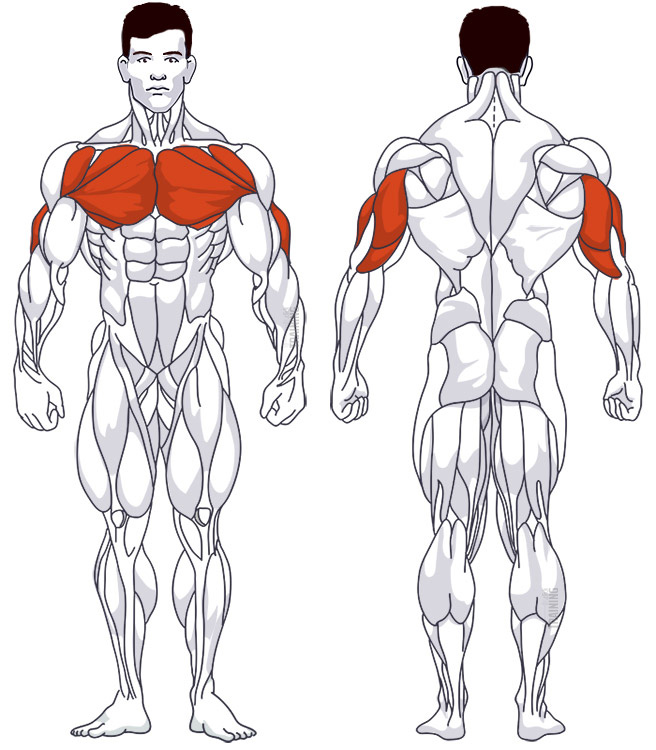Decline Push-Ups
Isolation exercise, Body weightThis article is verified by 1 study/publication.
Overview

Main muscles
- Chest: Large pectoral muscle
(Musculus pectoralis major) - Chest: Small pectoral muscle
(Musculus pectoralis minor) - Shoulder: Anterior deltoid muscle
(Musculus deltoideus, Pars clavicularis) - Triceps: Three-headed arm muscle
(Musculus triceps brachii)
Decline Push-Ups: Basics and alternatives

Involved main muscle groups:
Decline Push-Ups
Decline push-ups are a variation of the classic push-up. The movement is basically the same: with extended arms and a straight body, you support yourself on your hands and toes, and move your upper body by bending and extending your arms.
The key difference is where you place your feet. Instead of having your toes on the ground, you use a higher object, like a flat bench, for decline push-ups.
This means your legs are always at least as high as your upper body, shifting the center of gravity toward your upper body and increasing the training intensity.[1]
Correct execution
Just like regular push-ups, you can perform decline push-ups in various ways. The height of the leg support determines the training intensity. The higher your toes rest, the further the center of gravity moves towards your upper body, and the greater the training stimulus.
Of course, there’s a limit, because if you position your legs too high, the muscle stimulus shifts more towards your shoulders, and your shoulder joints will be more heavily stressed.
As a rule of thumb, you can assume a height of between 30 and 60 centimeters for supporting your legs.
If decline push-ups become too easy for you over time, despite the higher intensity, you can also use additional weight. In this case, it’s advisable to switch to the regular exercise variant as described in push-ups with additional weight.
Video tutorial
Step-by-step instructions
Kneel on the ground and lean forward, supporting yourself with your arms (shoulder-width apart).
Extend both legs and place your toes securely on the elevated object (flat bench, chair, sofa, etc.).
Extend both arms and position your hands roughly below your shoulders. Keep your hands no more than shoulder-width apart.
Tighten your core, so your head, upper body, and legs form almost a straight line. Don’t stick your butt out too far or let your hips sag. You’re now in the starting position.
Slowly and controlled, lower your upper body by bending your arms. End the movement when your elbows are completely bent or your chest is about to touch the ground.
Hold the position for a moment and straighten your arms (almost) completely. Keep your body tense in the manner described above throughout the entire movement.
Common Mistakes
Many potential mistakes in decline push-ups are the same as in the classic version. Make sure your legs, butt, and head form a line. Keep your body straight throughout the entire exercise, without sticking your butt out too far or letting your hips sag.
Additionally, use the full range of motion. That means you should straighten your arms (almost) completely and go down as far as possible with your upper body. Hastily training with a limited range of motion reduces the training stimulus.
Another source of error is the height of the leg support. As mentioned before, it shouldn’t be too high, because then the center of gravity will shift so far forward that your shoulders and shoulder joints will be taxed instead of your chest muscles and triceps.
Sources
- Kinetic Analysis of Several Variations of Push-Ups. Ebben, W. P., Wurm, B., VanderZanden, T. L., Spadavecchia, M. L., Durocher, J. J., Bickham, C. T., & Petushek, E. J. (2011). Journal of Strength and Conditioning Research, 25(10), 2891–2894. doi:10.1519/jsc.0b013e31820c8587. URL: https://pubmed.ncbi.nlm.nih.gov/21873902/, retrieved on 18.11.2020